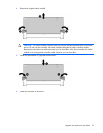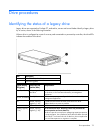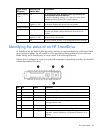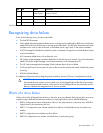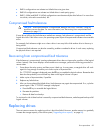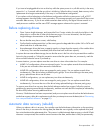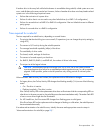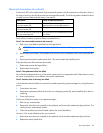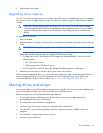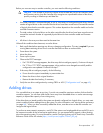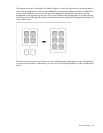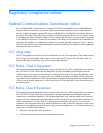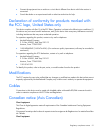
Drive procedures 86
3.
Restore data from backup.
Upgrading drive capacity
You can increase the storage capacity on a system, even if there are no available drive bays, by swapping
drives one at a time for higher capacity drives. This method is viable as long as a fault-tolerance method is
running.
CAUTION: Because data rebuild time ranges from 200 to 520 GB/h, the system could be
unprotected against drive failure for an extended period during data recovery or a drive capacity
upgrade. When possible, perform rebuild operations only during periods of minimal system
activity.
To upgrade drive capacity:
1. Back up all data.
2. Replace any drive. The data on the new drive is re-created from redundant information on the remaining
drives.
CAUTION: Do not replace any other drive until data rebuild on this drive is complete.
When data rebuild on the new drive is complete, LED behavior changes:
o For legacy drives, the Online/Activity LED changes from flashing steadily (1 Hz) to one of the
following states:
— On—The drive is inactive.
— Flashing irregularly—The drive is active.
o For HP SmartDrives, the Drive status LED changes from flashing green to solid green.
3. Repeat the previous step for the other drives in the array, one at a time.
When you have replaced all drives, you can use the extra capacity to either create new logical drives or
extend existing logical drives. For more information, see the Configuring Arrays on HP Smart Array
Controllers Reference Guide on the HP website (http://www.hp.com/support/CASAC_RG_en).
Moving drives and arrays
You can move drives to other ID positions on the same array controller. You can also move a complete array
from one controller to another, even if the controllers are on different servers.
Before moving drives, you must meet the following conditions:
• If moving the drives to a different server, be sure the new server has enough empty bays to
accommodate all the drives simultaneously.
• The array does not have failed or missing drives.
• No spare drive in the array is acting as a replacement for a failed drive.
• The controller is not performing capacity expansion, capacity extension, or RAID or stripe size
migration.
• The controller is using the latest firmware version.
• The server is powered down.



